Developmental biology is the study of the process by which animals and plants grow and develop. Developmental biology also encompasses the biology of regeneration, asexual reproduction, metamorphosis, and the growth and differentiation of stem cells in the adult organism.

Arabidopsis thaliana, the thale cress, mouse-ear cress or arabidopsis, is a small flowering plant native to Eurasia and Africa. A. thaliana is considered a weed; it is found along the shoulders of roads and in disturbed land.

The vascular cambium is the main growth tissue in the stems and roots of many plants, specifically in dicots such as buttercups and oak trees, gymnosperms such as pine trees, as well as in certain other vascular plants. It produces secondary xylem inwards, towards the pith, and secondary phloem outwards, towards the bark.
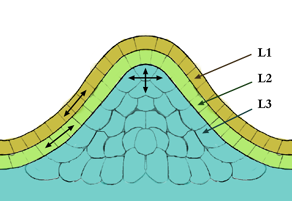
The meristem is a type of tissue found in plants. It consists of undifferentiated cells capable of cell division. Cells in the meristem can develop into all the other tissues and organs that occur in plants. These cells continue to divide until a time when they get differentiated and then lose the ability to divide.
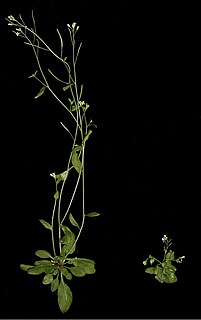
Plant hormones are signal molecules, produced within plants, that occur in extremely low concentrations. Plant hormones control all aspects of plant growth and development, from embryogenesis, the regulation of organ size, pathogen defense, stress tolerance and through to reproductive development. Unlike in animals each plant cell is capable of producing hormones. Went and Thimann coined the term "phytohormone" and used it in the title of their 1937 book.

Auxins are a class of plant hormones with some morphogen-like characteristics. Auxins play a cardinal role in coordination of many growth and behavioral processes in plant life cycles and are essential for plant body development. The Dutch biologist Frits Warmolt Went first described auxins and their role in plant growth in the 1920s. Kenneth V. Thimann (1904-1997) became the first to isolate one of these phytohormones and to determine its chemical structure as indole-3-acetic acid (IAA). Went and Thimann co-authored a book on plant hormones, Phytohormones, in 1937.

Cytokinins (CK) are a class of plant hormones that promote cell division, or cytokinesis, in plant roots and shoots. They are involved primarily in cell growth and differentiation, but also affect apical dominance, axillary bud growth, and leaf senescence. Folke Skoog discovered their effects using coconut milk in the 1940s at the University of Wisconsin–Madison.
Plant embryogenesis is a process that occurs after the fertilization of an ovule to produce a fully developed plant embryo. This is a pertinent stage in the plant life cycle that is followed by dormancy and germination. The zygote produced after fertilization must undergo various cellular divisions and differentiations to become a mature embryo. An end stage embryo has five major components including the shoot apical meristem, hypocotyl, root meristem, root cap, and cotyledons. Unlike animal embryogenesis, plant embryogenesis results in an immature form of the plant, lacking most structures like leaves, stems, and reproductive structures. However, both plants and animals pass through a phylotypic stage that evolved independently and that causes a developmental constraint limiting morphological diversification.
Florigen is the hypothesized hormone-like molecule responsible for controlling and/or triggering flowering in plants. Florigen is produced in the leaves, and acts in the shoot apical meristem of buds and growing tips. It is known to be graft-transmissible, and even functions between species. However, despite having been sought since the 1930s, the exact nature of florigen is still disputed.
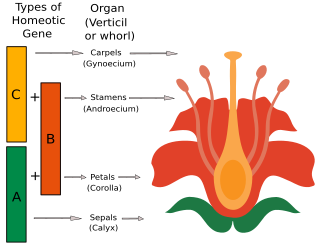
The ABC model of flower development is a scientific model of the process by which flowering plants produce a pattern of gene expression in meristems that leads to the appearance of an organ oriented towards sexual reproduction, a flower. There are three physiological developments that must occur in order for this to take place: firstly, the plant must pass from sexual immaturity into a sexually mature state ; secondly, the transformation of the apical meristem's function from a vegetative meristem into a floral meristem or inflorescence; and finally the growth of the flower's individual organs. The latter phase has been modelled using the ABC model, which aims to describe the biological basis of the process from the perspective of molecular and developmental genetics.
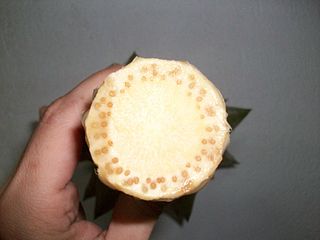
A primordium in embryology, is an organ or tissue in its earliest recognizable stage of development. Cells of the primordium are called primordial cells. A primordium is the simplest set of cells capable of triggering growth of the would-be organ and the initial foundation from which an organ is able to grow. In flowering plants, a floral primordium gives rise to a flower.
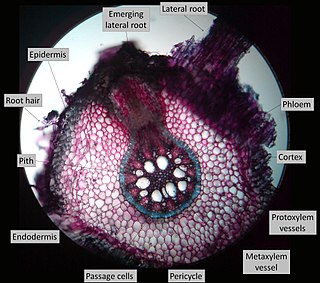
Lateral roots, emerging from the pericycle, extend horizontally from the primary root (radicle) and over time makeup the iconic branching pattern of root systems. They contribute to anchoring the plant securely into the soil, increasing water uptake, and facilitates the extraction of nutrients required for the growth and development of the plant. Lateral roots increase the surface area of a plant's root system and can be found in great abundance in several plant species. In some cases, lateral roots have been found to form symbiotic relationships with rhizobia (bacteria) and mycorrhizae (fungi) found in the soil, to further increase surface area and increase nutrient uptake.
AGAMOUS (AG) is a homeotic gene and MADS-box transcription factor from Arabidopsis thaliana. The TAIR AGI number is AT4G18960.
Peptide signaling plays a significant role in various aspects of plant growth and development and specific receptors for various peptides have been identified as being membrane-localized receptor kinases, the largest family of receptor-like molecules in plants. Signaling peptides include members of the following protein families.
LEAFY is a plant gene that causes groups of undifferentiated cells called meristems to develop into flowers instead of leaves with associated shoots.
Ling Meng, Ph.D., is a Chinese plant biologist in the Department of Plant and Microbial Biology at the University of California, Berkeley. She is currently a Postdoctoral Fellow at Lawrence Berkeley National Laboratory. She is best known for discovering a novel form of cellular communication in plants. Thioredoxin, while known to play an important role in biological processes such as cellular redox, is not fully understood in function. Meng's work at Berkeley has suggested that thioredoxin h9 is associated with the plasma membrane and is capable of moving from cell to cell through two important protein post-translation modifications: myristoylation and palmitoylation. She is the first to connect thioredoxin with the plasma membrane.
Lewis Jeffrey Feldman is a professor of plant biology at the University of California, Berkeley and is Associate Dean for Academic Affairs in the College of Natural Resources. He is in the Department of Plant and Microbial Biology. Feldman has taught at Berkeley since 1978. He received Berkeley's Distinguished Teaching Award in 1996. Feldman's research focuses on regulation of development in meristems/stem cells, root gravitropism, and redox regulation of plant development.
Plants depend on epigenetic processes for proper function. Epigenetics has been defined as "the study of changes in gene function that are mitotically and/or meiotically heritable and that do not entail a change in DNA sequence". Epigenetic examines proteins' interactions with DNA and its associated components, including histones and various modifications such as methylation, which alter the rate or target of transcription. Epigenetic mechanisms are required for proper regulation while epi-alleles and epi-mutants, much like their genetic complements, describe changes in phenotype associated with distinct epigenetic circumstance. There has been scientific enthusiasm for the study of epigenetics in plants because of their long-standing importance in agriculture.
A cytokinin signaling and response regulator protein is a plant protein that is involved in a two step cytokinin signaling and response regulation pathway.










